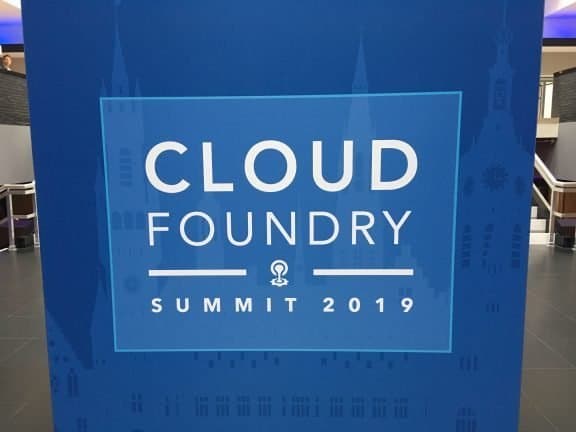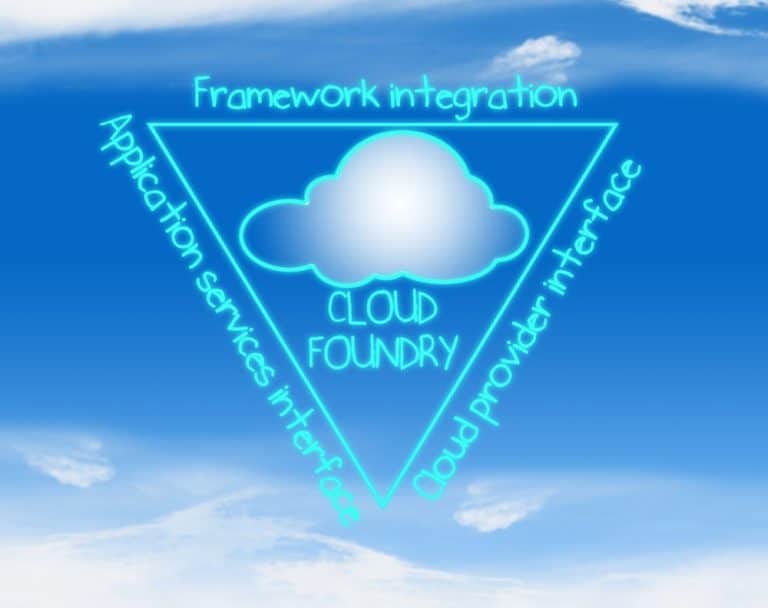For many companies and organizations, Cloud Foundry is a good option to bring their applications to the (multi)cloud quickly and easily. Still, the open source application PaaS platform is under pressure from other cloud native technologies, and has to respond more and more to this. We noticed this during the Cloud Foundry Summit Europe 2019. Techzine spoke about this with Executive Director Abby Kearns, of the open source project Cloud Foundry Foundation.
First, we will introduce what Cloud Foundry (CF) can do for developers within companies and organizations. Cloud Foundry was designed within the ranks of VMware in 2009.
With this open source Platform-as-a-Service (PaaS) and related services, companies and organizations can easily and quickly develop successive versions of applications, roll them out to various multicloud environments and manage them. It is particularly suitable for achieving continuous delivery. In this way, CF supports the entire lifecycle, from design and test phases to actual multicloud deployment.
CF’s architecture
CF’s container-based architecture makes it possible to easily and quickly roll out applications to various multi-client environments. Buildpacks are used to build these containers. For each specific code language in which a specific application is written, Go, Java, .Net Core, PHP, Python, Ruby or Node.js, it is determined which specific buildpack is used for an application. The entire process of coding, building, packaging in a container, and the roll-out and running of the applications is carried out within CF by the Diego tool. Diego ensures that applications end up in so-called ‘cells’, before they are rolled out to the multicloud again.
CF has two different services for roll-out to the multicloud. The first is Cloud Foundry Application Runtime (CFAR). This tool allows developers to package and deploy applications with a single CF command. This is roughly the basis of the PaaS platform.
There is also the tool BOSH. With this, the CF containers can be rolled out to any infrastructure with which BOSH can communicate, with an API. These include the various public cloud environments, VMware vSphere and bare metal.
Cloud Foundry and the Cloud Foundry Foundation
As of 2015, the PaaS platform will be housed as open source in a separate foundation, the Cloud Foundry Foundation. The Cloud Foundry Foundation manages all intellectual property, such as the source code and various trademark rights. In addition, it acts as coordinator of the community around the platform.
The Cloud Foundry Foundation has several members who need to further support the use of the PaaS platform. These are major providers such as Dell EMC, IBM, VMware, Pivotal, SAP and SUSE. In the end, the activities of the members vary quite a bit. Microsoft and Google are also members, but also Fujitsu, system integrators such as Atos and Capgemini and low-code specialist Mendix.
In addition to the open source version, commercial distributions are also marketed. These come from, among others, Pivotal (which, in all probability, will soon return to the VMware mothership), IBM and SUSE.
Adoption is increasing
A survey presented at the CF Summit Europe 2019 – based on a total of 306 respondents – shows that the adoption of the PaaS platform, be it the open source version or a commercial distribution, has increased again and will continue to do so. Approximately 50 percent of respondents said they use CF in their application processes, and over 40 percent said they run more than 50 applications on this platform. The number of companies that migrates applications to CF is currently at 68 percent.
In addition, the time needed to develop and deploy applications in multicloud environments will only decrease. The application life cycle will be less than three weeks with CF. According to Executive Director Abby Kearns, this is good news for developers. They can focus even more on their actual core tasks: building applications and writing code.
In the Netherlands, Rabobank is a major user of the platform. With the help of CF, this bank manages a total of more than 900 applications. This is now done with just two employees instead of the 60 that were previously required for application management.
Surviving turbulent times
Despite these seemingly positive developments, the open source PaaS platform must be alert, and constantly embrace new technology. According to Kearns, the whole process of digital transformation that customers – including the IT industry – are going through, can best be compared to a white-water river. Changes are taking place at an ever-increasing pace, such as accelerations due to the emergence of new technology, which makes navigating this chaos a challenge.

Cloud Foundry and the associated ecosystem cannot escape this either. The open source PaaS platform – just like customers and other IT suppliers – is, according to Kearns, a ‘kayak’ that has to find its way on this white-water river with all its various rapids, rocks and drops. This is done by constantly adapting and changing faster, by embracing the multi-platform concept – here, she is referring to the new emerging technologies – and by continuing to stimulate the open source community.
Emergence of new technology
When it comes to new technology that needs to be embraced, CF’s focus is on the orchestration tool for Kubernetes containers, among other things. In addition, Istio, which offers service mesh and focuses strongly on microservices, is also increasingly knocking on the door.
The influence of Kubernetes on CF is most important at the moment, as turned out during the event. Since a few years, after the orchestration tool for containers was considered sufficiently stable and mature, the Cloud Foundry Foundation is energetically integrating this technology in the open source PaaS platform. It goes without saying that this will be done in close cooperation with the community, and also with the commercial distributions. According to the Cloud Foundry Foundation, the ultimate goal of this integration is to replace certain parts of the CF architecture in the future.
More simplicity for developers
Kearns finds it important to have these technologies – and especially Kubernetes – on board. About the impact of the container orchestration tool on the Cloud Foundry platform, she says that the integration is mainly aimed at making things easier for developers. According to the Cloud Foundry Foundation, it will soon offer more possibilities.
Kubernetes makes things easier for developers, especially in the area of infrastructure. CF makes application development easier. Kearns therefore sees the meeting of both technologies as a ‘win-win’ situation.
Working on integration
The integration of Kubernetes takes place in three projects: CF Container Runtime, Quarks and Eirini. The CF Container Runtime project is a CF certified version of Kubernetes. This version is actually a kind of BOSH packaging for the container orchestration tool. In this case, BOSH manages the Kubernetes clusters.
Within Project Quarks, led by SUSE, CFAR applications are not packaged as a virtual machine, but as a container. In this case, Docker images that can be rolled out within Kubernetes. The idea is that this will make the transition easier once again.
Project Eirini aims to give developers a choice for their CFAR applications between CF Diego as a container scheduler or the Kubernetes platform. Applications can therefore be rolled out to Kubernetes pods. One of the reasons for this is to give companies that already use the latter platform more flexibility with applications via the CF platform. Meanwhile, all commercial distributors of the open source organization are certified for Eirini.
Distributions
The commercial distributions, such as Pivotal, SUSE and IBM, have now also fully embraced Kubernetes in their distributions. Big Blue even went so far as to announce a further integration of CF with Red Hat OpenShift. The ecosystem around CF is therefore in a state of flux and it is undeniably Kubernetes that is setting the pace.
The future is uncertain
Cloud Foundry is a convenient open source project that uses cloud native technology to make the entire application lifecycle, from design and deployment to the multicloud, as simple as possible for developers. Many major industry players have, in one way or another, joined the open source technology. The number of users and partners of the open source PaaS platforms is increasing, and the distributions are working hard to develop it further, together with the community.
Cloud Foundry does indeed have a white-water river ahead of it. This is mainly due to the emergence of new technologies, such as Kubernetes and also Istio, which can replace more and more parts of the platform. This makes the future of the platform a bit uncertain, but the Cloud Foundry Foundation is already energetically adapting.
Therefore, we are very curious as to how CF will develop further in the coming period. Especially interesting is how it plans to keep up with rapidly developing cloud native technologies.
